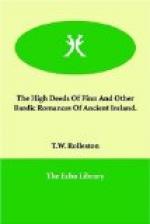Another more modern romantic element in the Fenian legends is the delight in hunting, and that more affectionate relation of men to animals which always marks an advance in civilization. Hunting, as in medieval romance, is one of the chief pleasures of the Fenians. Six months of the year they passed in the open, getting to know every part of the country they had to defend, and hunting through the great woods and over the hills for their daily food and their daily delight. The story of the Chase of the Gilla Dacar tells, at its beginning, of a great hunting and of Finn’s men listening with joy to the cries of the hunters and the loud chiding of the dogs; and many tales celebrate the following of the stag and the wild boar from early dawn to the evening. Then Finn’s two great hounds, Bran and Sceolaun, are loved by Finn and his men as if they were dear friends; and they, when their master is in danger or under enchantment wail like human beings for his loss or pain. It is true Cuchulain’s horses weep tears of blood when he goes forth to his last battle, foreknowing his death; but they are immortal steeds and have divine knowledge of fate. The dogs of Finn are only dogs, and the relation between him and them is a natural relation, quite unlike the relation between Cuchulain and the horses which draw his chariot. Yet Finn’s dogs are not quite as other dogs. They have something of a human soul in them. They know that in the milk-white fawn they pursue there is an enchanted maiden, and they defend her from the other hounds till Finn arrives. And it is told of them that sometimes, when the moon is high, they rise from their graves and meet and hunt together, and speak of ancient days. The supernatural has lessened since the heroic cycle. But it is still there in the Fenian.
Again, the Fenian cycle of tales is more influenced by Christianity than the others are. The mythological cycle is not only fully pagan, it is primeval. It has the vastness, the savagery, the relentlessness of nature-myths, and what beauty there is in it is akin to terror. Gentleness is unknown. There is only one exception to this, so far as I know, and that is in the story of The Children of Lir. It is plain, however, that the Christian ending of that sorrowful story is a later addition to it. It is remarkably well done, and most tenderly. I believe that the artist who did it imported into the rest of the tale the exquisite tenderness which fills it, and yet with so much reverence for his original that he did not make the body of the story Christian. He kept the definite Christian element to the very end, but he filled the whole with its tender atmosphere.
No Christianity and very little gentleness intrude into the heroic cycle. The story of Christ once touches it, but he who put it in did not lose the pagan atmosphere, or the wild fierceness of the manners of the time. How it was done may be read in this book at the end of the story of the Vengeance of Mesgedra. Very late in the redaction of these stories a Christian tag was also added to the tale of the death of Cuchulain, but it was very badly done.




